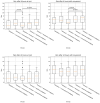Assessing the Experience and Management of Acute Post-Operative Pain from Caesarean Delivery: A Multi-Centre Cohort Study
- PMID: 40649012
- PMCID: PMC12250761
- DOI: 10.3390/jcm14134638
Assessing the Experience and Management of Acute Post-Operative Pain from Caesarean Delivery: A Multi-Centre Cohort Study
Abstract
Background: Caesarean section is considered one of the surgeries with the highest prevalence of postoperative pain, yet this is often underestimated and undertreated. This study was aimed at evaluating the prevalence and severity of postoperative pain, assessing which analgesic strategy is the most effective and identifying those risk factors associated with poorer analgesic results. Methods: A multi-centre observational study was conducted on 514 women undergoing elective caesarean section. The primary endpoints included postoperative pain severity at rest and with movement at 6 and 24 h. Results: The combination of intrathecal morphine and fentanyl with acetaminophen and Non Steroid Anti-inflammatory Drugs (NSAIDs) was associated with better pain control than any of the following treatments: intrathecal fentanyl with systemic acetaminophen and NSAIDs (2.49 ± 2.04 vs. 3.91 ± 2.75, ES = -0.610, p = 0.01), elastomeric pump at 6 h at rest (2.49 ± 2.04 vs. 4.10 ± 2.86, ES -0.733, p = 0.04) and with movement (4.44 ± 2.41 vs. 6.14 ± 3.08, ES -0.671, p = 0.01) or epidural analgesia (4.44 ± 2.41 vs. 5.65 ± 2.57, ES -0.496, p = 0.02). No risk factors predicting poorer postoperative analgesia were found. Conclusions: The prevalence of postoperative pain control after elective caesarean section is high. The best analgesic postoperative regimen includes intrathecal morphine together with fentanyl and systemic analgesics. No risk factors associated with poorer outcomes were found.
Keywords: analgesia; caesarean section; obstetric; pain; pain measurement; postoperative.
Conflict of interest statement
The authors declare no conflicts of interest.
Figures


References
Grants and funding
LinkOut - more resources
Full Text Sources

